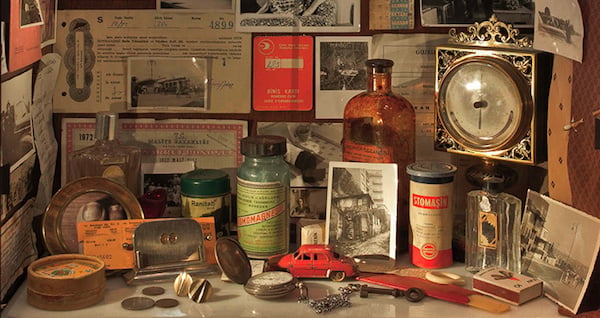Art & Exhibitions
Orhan Pamuk’s Museum of Innocence Comes to London
The author has sold over 11 million novels.

Photo via the Museum of Innocence
The author has sold over 11 million novels.

Amah-Rose Abrams

Nobel prize laureate and beloved author Orhan Pamuk’s Museum of Innocence, opened in London yesterday, installed in three of the upper rooms of Somerset House.
The installation, a version of a larger scale exhibition in Istanbul, recreates Pamuk’s novel of the same name that tells the story of star-crossed lovers, socialite Kemal Bey and his second cousin twice removed, shop-girl Füsun.
Their romance is marked with the mementos mentioned throughout the novel, which are echoed in thirteen vitrines containing objects that represent moments in their doomed relationship. The vitrines are tied together with sections of film providing context for the objects on view.
“This new touring exhibition will tell a different version of the love story set in Istanbul through objects and Grant Gee’s wonderful new film,” said Pamuk in a statement released by Somerset House. ”I’m delighted that The Museum of Innocence has been given a new life out in the wider world at Somerset House.”

A Vitrine from the Museum of Innocence at Somerset House
Photo: via the Museum of Innocence
The film, The Innocence of Memories, is a collaboration between Pamuk and director Grant Gee where events are retold by a secondary character from the novel Museum of Innocence.
The original installation, which was a venue for Arshile Gorky’s work at Carolyn Christov-Bakargiev’s critically acclaimed Istanbul Biennial, contained 83 vitrines of objects relating the 83 chapters in the book which Pamuk says he conceived simultaneously.
“The more objects I collected, the more I wrote,” Pamuk told AFP. “Each object Kemal collected represents a moment in their history. The lines that connect objects create stories and the lines that connect moments create time.”
The boxes taken from the installation in Istanbul are what Pamuk considered to be the strongest visually.
“They are objects you would find on bed tables at the time. The novel is also autobiographical,” he added. “For example, box 74 is about the death of Kemal’s father,” explained the author.

A Vitrine from the Museum of Innocence in Istanbul
Photo: via the Museum of Innocence
Pamuk is well known for speaking out about the political situation in Turkey and lived in exile in Germany for six years after writing an article on the Armenian genocide and deaths of Kurds in 2005, which led to charges being brought against him. Following rumors that SALT Beyoğlu closed due to governmental pressure, it seems that there are still issues with freedom of expression in Turkey.
“It is a very bad situation, university professors are being pressured and imprisoned for signing a petition,” Pamuk told AFP, speaking out about fighting between Kurdish rebels and government forces. “It has nothing to do with free speech. We have an electoral democracy, but not a full democracy.”
“It’s always on one’s mind, it’s a problem for everyone,” he added.
Jonathan Reekie, director of Somerset House Trust is currently in talks to tour the exhibition to Belgium, France, and the United States.
“Museum of Innocence” is on view at Somerset House from January 27 – April 10.